
German fire department
Encyclopedia
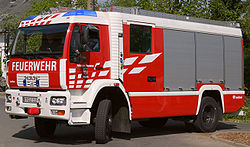

Emergency medical services
Emergency medical services are a type of emergency service dedicated to providing out-of-hospital acute medical care and/or transport to definitive care, to patients with illnesses and injuries which the patient, or the medical practitioner, believes constitutes a medical emergency...
in numbers corresponding to the inhabitants of the county or city. In cities, this is usually performed by the Fire Prevention Bureau, one of the higher-ranking authorities.
Most of Germany's 1,383,730 fire fighters are members of voluntary fire brigades
Volunteer fire department
See also the Firefighter article and its respective sections regarding VFDs in other countries.A volunteer fire department is a fire department composed of volunteers who perform fire suppression and other related emergency services for a local jurisdiction.The first organized force of...
, with a lesser number working in professional fire brigades either operated by
- a municipal body like the city of BerlinBerlinBerlin is the capital city of Germany and is one of the 16 states of Germany. With a population of 3.45 million people, Berlin is Germany's largest city. It is the second most populous city proper and the seventh most populous urban area in the European Union...
(Berufsfeuerwehr - full-time city department) - a larger company ("Werkfeuerwehr", for the needs of the company operating them) eg. refineries or chemical industry production facilities
- airports to meet the ICAO requirements ("Flughafenfeuerwehr" - this includes airplane factories like that of AirbusAirbusAirbus SAS is an aircraft manufacturing subsidiary of EADS, a European aerospace company. Based in Blagnac, France, surburb of Toulouse, and with significant activity across Europe, the company produces around half of the world's jet airliners....
in Hamburg) - the armed forces ("BundeswehrBundeswehrThe Bundeswehr consists of the unified armed forces of Germany and their civil administration and procurement authorities...
-Feuerwehr" with specialized divisions such as "Fliegerhorstfeuerwehr Cologne-Wahn"/located at German air force bases, military bases, naval bases as well as on any ship of the German navy).
By law, cities with a population of more than 80,000-100,000 people (depending on the state) are required to have a professional fire fighting force ("Berufsfeuerwehr"). Others such as smaller cities and towns can set up a full-time force ("Hauptamtliche Wachbereitschaft") which is basically a group or a squadron occupying one large fire station around the clock. This force deals on its own with smaller issues and is supported by voluntary forces in bigger issues. Each community meets the need of fire-fighting personnel by setting up a voluntary force ("Freiwillige Feuerwehr"). It is also possible that a community or a city sets up a professional fire fighting force without additional volunteer forces. In case it is not possible to recruit enough personnel for this job, the mayor of a city is required to set up a "Pflichtfeuerwehr" (compulsory fire brigade), where he will draft the number of personnel required.
Overview
Voluntary and Professional Fire Brigades usually share the same basic layout when deploying. Firefighters are organized in tactical units as follows:| unit | translation | men | leader | comments |
|---|---|---|---|---|
| Trupp | Troop (squad) | 2 (as unit within other units) or 3 (as own tactical unit, e.g. vehicle crew) | squad leader | usually either the crew of an ambulance or ladder or part of the crew of an engine |
| Zugtrupp | platoon squad | 3 | platoon leader | the crew consists of 1 vice platoon leader, 1 assistant and 1 driver. Only in charge when 2 groups or more are needed |
| Staffel | squadron | 2 squads + engine operator | squadron leader | most common unit of professional fire fighting forces; minimum standard for firefighting |
| Gruppe | group | 3 squads + engine operator + message runner | group leader | smallest tactical unit to work independently; most common unit of voluntary fire fighting forces; usually the crew of an engine; the term message runner was created before radio electronics came into use, today the message runner can also act as second egine operator, supports a squad or is in charge for security surveillance (e.g. traffic regulation) |
| Löschzug | platoon | 2 groups + platoon squad | platoon leader | usually consisting of several vehicles, i.e. 1 command car, 1 engine, 1 tanker, 1 ladder and 1 ambulance |
In contrast to the United States system, there is no division into engine and ladder companies.
Organization of a Gruppe (group) or Staffel (squadron)
Most standard procedures in German firefighting are based on the Gruppe (group), since it is the smallest tactical unit to work independently. The also common Staffel (squadron) is basically a group stripped down to the absolutely necessary minimum, which can be easily extended to a Gruppe by joining with a 3 firefighter Trupp (squad) from another vehicle.The standard procedures for fire and technical aid/rescue assign certain tasks to certain crew members. This helps keeping the orders the unit commander has to give short and simple, since those tasks don't need to be specifically assigned to anyone.
| role | translation | tasks according to standard fire procedure | tasks according to standard technical aid/rescue procedure | comments |
|---|---|---|---|---|
| Einheitsführer | unit leader | commands the unit, is responsible for the crew's safety, determines placement of vehicle and, if necessary, of portable fire pump | commands the unit, is responsible for the crew's safety, determines placement of vehicle and, if necessary, of powered appliances like generators etc. | The more specific terms "Gruppenführer" (group leader) and "Staffelführer" (squadron leader) depending on the unit's size were abandoned |
| Maschinist | engine operator | drives the engine, operates the pump and other machinery, assists other crew members unloading equipment from the engine and building up water supply | drives the engine, operates powered appliances (e.g. generators, hydraulic pumps), assists other crew members unloading equipment from the engine | while driving, the engine operator is responsible for safety of crew and vehicle |
| Melder | message runner | carries out assigned tasks (e.g. assists the unit commander, provides assistance to a squad deploying a ladder, takes care of casualties, relays information) | carries out assigned tasks (e.g. assists the unit commander, assists with deploying appliances, takes care of casualties, relays information) | In a staffel (squadron) this position is not occupied |
| Angriffstrupp | attack squad | rescues (especially from areas only accessible with SCBA); deploys the Wye Wye Wye is a historic village in Kent, England, located some from Canterbury, and is also the main village in the civil parish of Wye with Hinxhill... (between main water supply line and attack lines); usually deploys the first nozzle |
rescues, provides first aid First aid First aid is the provision of initial care for an illness or injury. It is usually performed by non-expert, but trained personnel to a sick or injured person until definitive medical treatment can be accessed. Certain self-limiting illnesses or minor injuries may not require further medical care... until ambulance arrives and EMT Emergency medical technician Emergency Medical Technician or Ambulance Technician are terms used in some countries to denote a healthcare provider of emergency medical services... s take over, provides technical aid |
|
| Wassertrupp | water squad | rescues; builds up water supply for the engine; deploys portable ladder Ladder A ladder is a vertical or inclined set of rungs or steps. There are two types: rigid ladders that can be leaned against a vertical surface such as a wall, and rope ladders that are hung from the top. The vertical members of a rigid ladder are called stringers or stiles . Rigid ladders are usually... s on command; becomes rescue squad, if SCBAs are in use (Two-in, two-out Two-in, two-out In firefighting, the policy of two-in, two-out mandates that firefighters never go into a dangerous situation in a fire or rescue incident alone... ) |
secures the incident site against additional hazards using the necessary equipment, is free for other tasks after that | |
| Schlauchtrupp | hose squad | rescues; lays out attack lines for the other squads; deplouys portable ladder Ladder A ladder is a vertical or inclined set of rungs or steps. There are two types: rigid ladders that can be leaned against a vertical surface such as a wall, and rope ladders that are hung from the top. The vertical members of a rigid ladder are called stringers or stiles . Rigid ladders are usually... s on command; takes additional tasks like operating the Wye Wye Wye is a historic village in Kent, England, located some from Canterbury, and is also the main village in the civil parish of Wye with Hinxhill... or deploying additional appliances |
prepares the equipment for the attack squad, if necessary assists the attack squad and operates needed powered appliances; if the attack squad is busy providing first aid First aid First aid is the provision of initial care for an illness or injury. It is usually performed by non-expert, but trained personnel to a sick or injured person until definitive medical treatment can be accessed. Certain self-limiting illnesses or minor injuries may not require further medical care... , the hose squad takes over deploying the ordered appliances |
in a Staffel (squadron) this squad is missing, so the remaining two squads have to take over its tasks. |
Hierarchy
Members of the professional fire depts & volunteer fire depts serve in a hierarchy corresponding to other German institutions i.e. the Police.The volunteer firefighters ranks are as follows*:
Firefighters
Feuerwehrmannanwärter (FMA)/Trainee fresh to the firebrigade, at least 16 years (18 years in some German fire departments) old.
Feuerwehrmann (FM)/Firefighter after the first part of the basic training.
Oberfeuerwehrmann (OFM) after the second part of the basic training and after at least two years as Feuerwehrmann (FM)
Hauptfeuerwehrmann (HFM) after being Oberfeuerwehrmann (OFM) for five years.
Leaders
Löschmeister (LM) after being Hauptfeuerwehrmann for ten years or/and qualification "group leader" (Gruppenführer).
Oberlöschmeister (OLM) after being Löschmeister for ten years or/and qualification "platoon leader" (Zugführer).
Unterbrandmeister (UBM)(does not exist in Baden-Wuerttemberg) with completed training to leading a squad or platoon squad and at least one year being Oberfeuerwehrmann (OFM).
Brandmeister (BM) after at least two years as Unterbrandmeister (UBM) and two weeks training at the countys fireschool (F3). Allowed to command a squadron or group.
Oberbrandmeister (OBM) at least two years as Brandmeister (BM)
Hauptbrandmeister (HBM) at least five years as Oberbrandmeister (OBM)
Brandinspektor (BI) (does not exist in Baden-Wuerttemberg) after a training at the countys fireschool (F4). Allowed to command a platoon. Must have been Oberbrandmeister (OBM) before.
Brandoberinspektor (BOI) (does not exist in Baden-Wuerttemberg) after a training at the countys fireschool (F/B5). Allowed to command severals platoons. Must have been Brandinspektor (BI) before.
- ranks differ between states because each state is responsible for providing and admitting its own fire services as Thuringia i.e. provides education and administration of all fire brigades in Thuringia and Saxony provides it for all brigades in Saxony and so on.
Ranks of professionals
In Germany exist three Career groups with diffrent conditions.They are governed in a state law on Civil Servants.
Medium Grade
Brandmeister i.a. (in reversionary) in the most states starting the profesionals in this ranks. Condition is a complished vocational training in useful job (mostly craft or industrial)
Brandmeister (in Baden-Wuerttemberg is this the first grad) the same conditions like Brandmeister i.a.
The firefighters starting with a 18 month training time which ends with test. The use of Brandmeister is depent of the size of the fire department they are working for. In bigger departments mostly as water scuad in smaller departments also as attac scuad or engine operator
Oberbrandmeister used as water squad (leader) and attack squad, engine operator
Hauptbrandmeister (in bigger fire departments attack scuad leader in smaller also unit leader) ladder operator
executive grades
Brandinspektor i.A Condition to start directly in this grad is a college degree, starting with an 24 month training and end with an test.
Used mostly as unit leader (engine)
Brandoberinspektor Brandamtman Brandamtsrat and Brandoberamtsrat.Used mostly as platoon leader
senior civil service
Brandreferendar z.a/-assessor condition to start directly in this grad is an university degree
Brandrat, Oberbrandrat (some states: Brandoberrat), Branddirektor and Leitender Branddirektor. in Cities with more than 400 000 people exist top amt Direktor der Feuerwehr (NRW), Landesbranddirektor (Berlin), Oberbranddirektor (Hamburg, München), Direktor der Branddirektion (Hessen) oder Stadtdirektor (Baden-Württemberg (Stuttgart)). This grades are use in the functions of Division Chief/Deputy/Deputy Assistant oder Chief/Commissioner Assistant Chief/Commissioner, Chief/Commissioner dependet of the size of the city they are working for.
Vehicles
Technically, there are eleven types of vehicles in service today. However, due to regional needs and availability, there are a vast number of different vehicles in use.The eleven standardized types are:

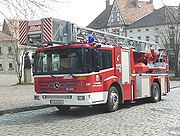

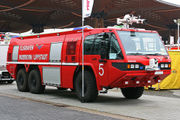
- Command Car/Battalion Chief; the Einsatzleitwagen (ELW). This type has 3 subtypes, ELW1, ELW2 and ELW3 with the first one usually being a van (sometimes sedan or SUV) and the last one having the size of a coach
- Small fire trucks; either the Tragkraftspritzenfahrzeug (TSF) or (TSF-W, Tragkraftspritzenfahrzeug mit Wasser with a water tank normally 500 to 750 liters), or the Kleinlöschfahrzeug (KLF). Usually modified panel truck with basic means of firefighting. Those vehicles usually have a portable fire pump with an own engine instead of a fixed one that is powered by the vehicle's engine. The names of the TSF and TSF-W are actually derived from the German term "Tragkraftspritze" which roughly translates into "portable self powered pump". Those vehicles are crewed by a German staffel (1:5), but the TSF and the TSF-W types provide enough equipment for a group (1:8).
- Engines; the Löschgruppenfahrzeug (LF). Typically a large truck manned by a group and carrying firefighting and rescue gear, nowadays usually with a small water (ranging from 800 to 2500 liters) and foam supply (60 or 120 liters depending on the type of fire engine). Although the crew of the LF consists of a group, the larger types of this engine carry enough equipment for two groups, which often includes a second, portable fire pump.
- Rescue Engines, the Hilfeleistungs-Löschgruppenfahrzeug (HLF). Similar to the engine (LF) but with far more rescue equipment (i.e. Jaws of Life and a winch) onboard.
- Tankers, the Tanklöschfahrzeug (TLF). Typically a large truck manned by one squad (1:2) or a German staffel (a group consisting of 1:5 (in the case of a TLF 16/25 - a TLF 16/25 with a 1600-liter/min pump and a 2500-liter water tank) and a water supply of several thousand litres). Very often they are equipped with water cannons on the roof and foam cannons.
- Rescue trucks, the Rüstwagen (RW).Usually either a larger panel truck or a smaller truck, they are equipped with a broad range of rescue gear i.e. Jaws of Life, a winch, saws, cutters or work platforms
- Equipment carriers, the Gerätewagen (GW). A vehicle that comes in all sizes, depending of the equipment stowed. Equipment might be specialized gear for water rescue operations or hazmat. Another variation is the Wechselladerfahrzeug (WLF) which is a specialized, heavy-duty truck WLFs and their modules used by the Cologne Fire Department with a mounted hydraulic crane arm behind the truck's cabin designed to lift heavy containers or modules (called Abrollbehälter) which contain specialized equipment (examples include mobile command modules/trailers, rescue gear modules, Self-Contained Breathing Apparatus modules, HazMat or environmental modules)
- Ladders, like the Drehleiter (DL or DLK). A large truck with a telescopic ladder (DL), often with an attached bucket or platform at the end (DLK). The most common type is the DLK 23-12, a ladder truck with a platform that can extend to 23 metres height while positioned 12 metres away.
- Hose Carriers, the Schlauchwagen (SW). Typically a large truck with a supply of rolled or folded and pre-coupled hoses, in case longer distances have to be bridged.
- Ambulances, the Rettungswagen (RTW). Typically based on a delivery-truck chassis with a special body, the RTW provides pre-hospital critical care for one patient. Crew constist of two EMT-I or EMT-P, sometimes augmented by an emergency physician.
- Crew Carrier, the Mannschaftstransportwagen (MTW). Usually a minivan or a small bus, used for non-emergency rides, organisational tours or transfer of additional personnel.
German airport firefighting vehicles
Specialized vehicles are used by German airport fire departments. These include crash engines. In German, these are called Flugfeldlöschfahrzeuge (FLFs). These normally have pumps with a large pumping capacity of 10,000 liters/min and have large supplies of either powder or foam (ranging between 300-800 liters) in addition to a standard water tank ranging from 6,000 to 13,000 liters. German airports tend to use crash engines manufactured by Rosenbauer (Rosenbauer Simba, Rosenbauer Panther 8x8 MA 5 or the Rosenbauer Panther 6x6 CA 5). Other manufacturers include Ziegler, Saval-Kronenburg, Amdac Carmichael International, Metz, E-One, Oshkosh, Sides, Magirus-Deutz/IVECO Magirus.German military bases are protected by the Bundeswehr-Feuerwehr which currently have 3 generations of Feuerlösch-KFZ (FlKfz) engines in use. These are specialized engines constructed in 3 different generations since 1958 and they use specialized military truck chassis (normally MAN/Mercedes Benz/Unimog). The first generation covers engines constructed between 1958 and 1978 (known as the FlKfz 2400).
The 2nd generation engines (FlKfz 1000 (equipment manufacturer: Metz now part of Rosenbauer) , FlKfz 3000 (equipment manufacturer: cooperation between Bachert and Albert Ziegler), FlKfz 3500/400/750 ((equipment manufacturer: cooperation between Bachert and Albert Ziegler) and FlKfz 8000/800 ((equipment manufacturer: http://www.schoerling-brock.de), (all constructed by Faun GmbH) except the FlKfz 1000 [constructed on an Mercedes Benz Unimog U 1300 L chassis] were first put into service in 1979.
The 3rd generation entered active service in 2005. Most of the older FlKfz 8000/800 were replaced by the new Ziegler Z8 ((FLF 80/125-12,5 Z8 „Advancer“)). Unlike the 2nd generation engines, this new series of 16 Z8 engines is no longer a military-specific design. The 1st generation of FlKfz 2400 was replaced by LF 16/12 (originally based on the Daimler-Benz 1017 chassis) with the design changes being incorporated into the Mercedes-Benz Atego chassis. Furthermore, the 3rd generation has been supplemented by the TLF 20-28 and the RW (Rüstwagen 2) on MAN 18.280 chassis as well as the TLF 20-45 on the Mercedes-Benz Unimog U 5000 chassis. All of these vehicles were equipped by Ziegler.
More information on the military vehicles mentioned above are available below:
Standard ELW 1/Command vehicle:
- http://www.panzerbaer.de/helper/bw_flkfz_elw-a.htm
- http://www.panzerbaer.de/helper/bw_flkfz_elw_lkw_00-9t_gl_wolf-a.htm
1st Generation:
2nd Generation:
3rd Generation:
Radios
German fire brigades all use 2-way-FM radio to coordinate their efforts. The German emergency currently use the so-called "BOS-Band" (BOS means "Behörden und Organisationen mit Sicherheitsaufgaben" = Authorities and organisations with security duties), channels located in the 4-meter and 2-meter bands with a frequency range from 74.215 to 87.255 MHz (4m/base stations) and from 167.56 to 173.98 MHz (2m/portable radios). There are plans to implement digitally scrambled trunked radio systems (a nationwide TETRA-based http://www.motorola.com/de/TETRATerminals/ system) located in many German cities by 2010. This process is being delayed in many cities due to either financial constraints (expenses due to setting up a whole new infrastructure and replacing numerous 4-meter base stations/mobile radios and 2-meter portable radios) or legislative delays. The city of Aachen began testing a TETRA-based system in 2001 and has implemented it since 2003 after completion of the pilot project http://www.motorola.com/governmentandenterprise/de/de-de/public/functions/browsesolution/Browsesolution.aspx?navigationpath=id_802i/id_2338i/SSONE3,http://www.motorola.com/governmentandenterprise/contentdir/en_GB/Files/CaseStudies/aachen.pdf.An enormous advantage of the German BOS Radio System is that virtually every helping organisation in Germany like Police, Rescue Services, THW, life-guard and Fire brigades are using the same system in different channels so they can easily switch and communicate.
Typically, 4-meter-radios http://www.motorola.com/governmentandenterprise/de/de-de/public/functions/browseproduct/Transnavone.aspx?navigationpath=id_801i/id_2290i#id_2418i,http://www.funkmelderservice.de/funk.htm#bos_4m,http://niros.sitekit.net/default.aspx?live=0&locid=062005001004004&SiteID=2381&lang=EN are used by dispatch centers and on vehicles, whereas 2-meter-radios are handheld Handie-Talkies http://www.motorola.com/governmentandenterprise/de/de-de/public/functions/browseproduct/Transnavone.aspx?navigationpath=id_801i/id_2290i#id_2417i,http://www.funkmelderservice.de/funk.htm#bos_2m,http://niros.sitekit.net/niros-trx-1012-atex.htm,http://niros.sitekit.net/niros-trx-5116-atex.htm for tactical communication on scene. Unlike in the US, 2-meter portable radios are normally only used for fireground/tactical communications and not for direct contact with the dispatch center. If direct communication is required, the engineer of the first-in engine will relay all messages directly to the dispatch center via the 4-meter radio on the engine. However, a dispatch center can monitor and if necessary respond on a (non-)repeatered 2-meter tactical channel. In most cases, German tactical channels are not used with a repeater.
In bigger areas, there is usually a number of relais stations/repeaters in place which repeat the signal, giving it more range and quality.
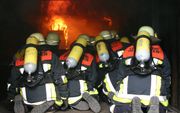
Identification
Radio identification names consist of five parts:- Name of the organisation, i.e. "FLORIAN" for the fire brigade
- Name of the city or county the brigade is based, i.e. "MAGDEBURG"
- Two digits referring to the specific area or station, i.e. "01"
- Two digits referring to the type of vehicle, i.e. "33" for a ladder
- Two digits referring to which one it is, i.e. "01" for the first vehicle of its type.
For example, the radio identification "Florian Magdeburg 01-33-01" would describe the first ladder of station 1, operated by the Fire Department of the city of Magdeburg
Magdeburg
Magdeburg , is the largest city and the capital city of the Bundesland of Saxony-Anhalt, Germany. Magdeburg is situated on the Elbe River and was one of the most important medieval cities of Europe....
.
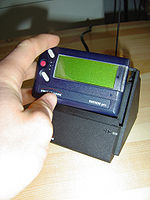
Because the German Fire Services are terms of the federal states like Bavaria
Bavaria
Bavaria, formally the Free State of Bavaria is a state of Germany, located in the southeast of Germany. With an area of , it is the largest state by area, forming almost 20% of the total land area of Germany...
, Hesse
Hesse
Hesse or Hessia is both a cultural region of Germany and the name of an individual German state.* The cultural region of Hesse includes both the State of Hesse and the area known as Rhenish Hesse in the neighbouring Rhineland-Palatinate state...
or Berlin
Berlin
Berlin is the capital city of Germany and is one of the 16 states of Germany. With a population of 3.45 million people, Berlin is Germany's largest city. It is the second most populous city proper and the seventh most populous urban area in the European Union...
this may vary from state to state. The radio identification name for the same ladder in Bavaria can be "Florian Geretsried 30/1" for example.
Alerting the Fire Brigade
All fires or emergencies requiring the service of the fire brigade can be reported by the toll-free number "112". The caller will be connected to the command centre responsible for his area and can report the emergency.The dispatcher will then decide, whom to alert. Since professional fire brigades are at the station, they will be alerted by klaxon, announcement and/or diplay messages. During the night, the alarm circuits are often wired to turn on the lights in the crew quarters.
Voluntary fire brigades are almost everywhere equipped with pager
Pager
A pager is a simple personal telecommunications device for short messages. A one-way numeric pager can only receive a message consisting of a few digits, typically a phone number that the user is then requested to call...
s, some only informing the firefighters of an emergency (spoken messages on a pager), some even displaying short messages (display pagers such as the Motorola LX2/LX2plus or LX4/LX4plus) with the type of call, incident address, map coordinates, time and date of call and other important details. In some areas siren
Siren (noisemaker)
A siren is a loud noise making device. Most modern ones are civil defense or air raid sirens, tornado sirens, or the sirens on emergency service vehicles such as ambulances, police cars and fire trucks. There are two general types: pneumatic and electronic....
s are still in use, sometimes even as the primary means of alerting firefighters.
A few fire brigades are experimenting with a GSM-based alarm circuit. The firefighter will then get either a message on his mobile phone or a machine will call him. This method has proven successful in areas, where constant radio contact for pagers can not be guaranteed, i.e. in mountainous areas.

